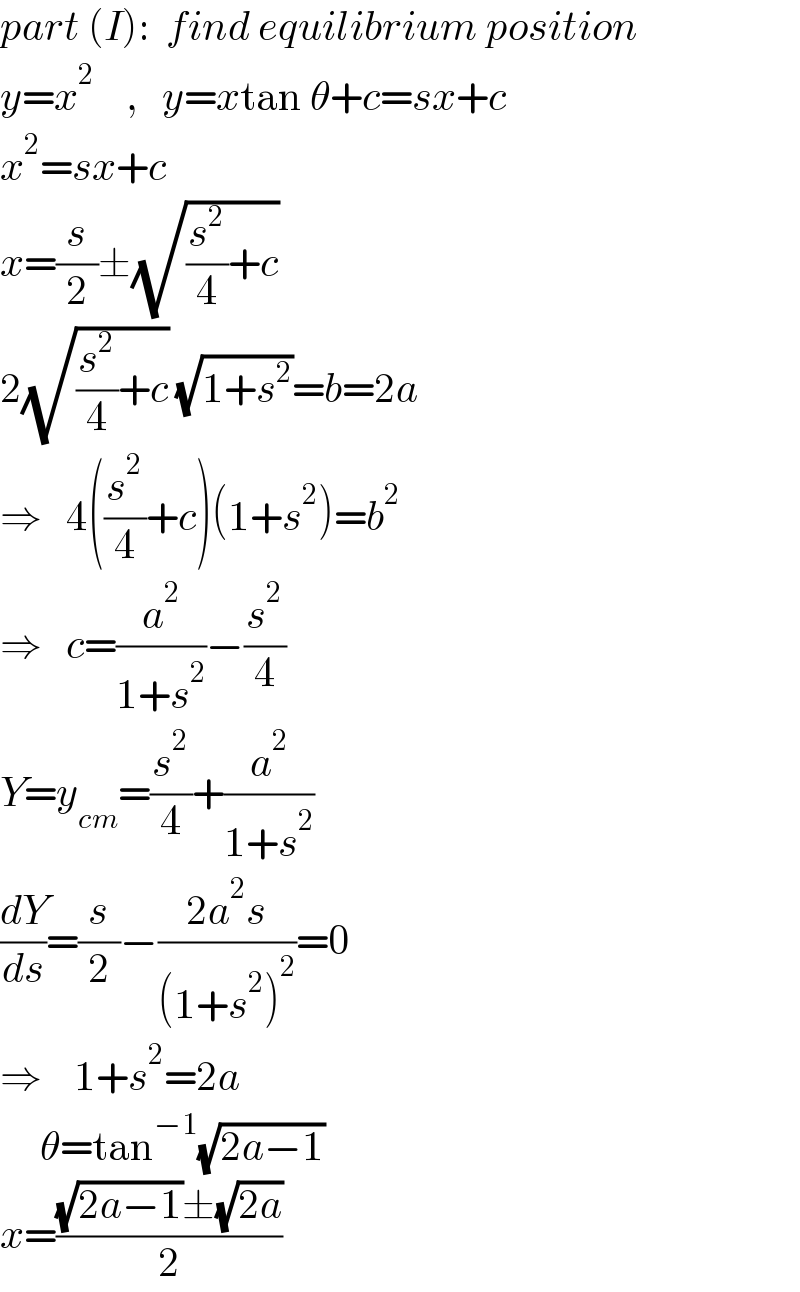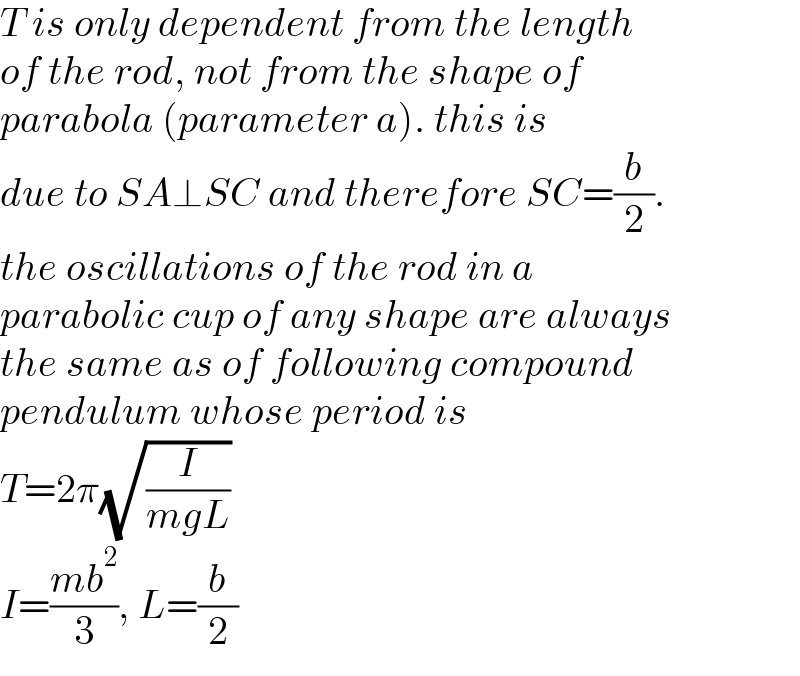
Question and Answers Forum
Question Number 164345 by mr W last updated on 16/Jan/22

Commented by mr W last updated on 18/Jan/22

Answered by ajfour last updated on 16/Jan/22

Commented by mr W last updated on 17/Jan/22

Commented by ajfour last updated on 18/Jan/22
yes sir.
Commented by mr W last updated on 18/Jan/22

Answered by mr W last updated on 17/Jan/22

Commented by mr W last updated on 18/Jan/22
![see also Q164073 parabola y=(x^2 /a) with a=1 here length of rod is b. C=center of mass say the end points of the rod are A(−p, (p^2 /a)), B(q, (q^2 /a)) tan φ=−(dy/dx)∣_(x=−p) =((2p)/a) tan ϕ=(dy/dx)∣_(x=q) =((2q)/a) tan γ=(((q^2 /a)−(p^2 /a))/(q+p))=((q^2 −p^2 )/(a(q+p)))=((q−p)/a) α=(π/2)−φ−γ β=(π/2)−ϕ+γ ((SC)/(AC))=((sin α)/(sin φ))=((sin ((π/2)−φ−γ))/(sin φ))=((cos (φ+γ))/(sin φ)) ((SC)/(CB))=((sin β)/(sin ϕ))=((sin ((π/2)−ϕ+γ))/(sin ϕ))=((cos (ϕ−γ))/(sin ϕ)) since AC=CB=(b/2), ((cos (φ+γ))/(sin φ))=((cos (ϕ−γ))/(sin ϕ)) ((cos φ cos γ−sin φ sin γ)/(sin φ))=((cos ϕ cos γ+sin ϕ sin γ)/(sin ϕ)) ((cos γ)/(tan φ))−sin γ=((cos γ)/(tan ϕ))+sin γ (1/(tan φ))−(1/(tan ϕ))=2 tan γ (a/(2p))−(a/(2q))=((2(q−p))/a) ((q−p)/(pq))=((4(q−p))/a^2 ) ⇒q−p=0 ⇒p=q ⇒horizontal position or ⇒(1/(pq))=(4/a^2 ) ⇒pq=(a^2 /4) ⇒inclined position we consider the inclined position of rod, which is generally the only stable equilibrium position. (q+p)^2 +((q^2 /a)−(p^2 /a))^2 =b^2 (q+p)^2 [1+(((q−p)^2 )/a^2 )]=b^2 (q+p)^2 [1+(((q+p)^2 −4pq)/a^2 )]=b^2 (q+p)^2 [1+(((q+p)^2 −a^2 )/a^2 )]=b^2 (q+p)^4 =a^2 b^2 ⇒p+q=(√(ab)) p and q are roots of z^2 −(√(ab))z+(a^2 /4)=0 ⇒p=(((√(ab))−(√(a(b−a))))/2) ⇒q=(((√(ab))+(√(a(b−a))))/2) tan (ϕ+φ)=((((2p)/a)+((2q)/a))/(1−((2p)/a)×((2q)/a)))=((2a(p+q))/(a^2 −4pq))=((2a(p+q))/(a^2 −a^2 )) ⇒ϕ+φ=90° ⇒SA⊥SB ⇒SC=((AB)/2)=(b/2) h=SC×θ=((bθ)/2) I_S =((mb^2 )/(12))+m((b/2))^2 =((mb^2 )/3) I_S (d^2 θ/dt^2 )=−mgh ((mb^2 )/3) (d^2 θ/dt^2 )=−mg((bθ)/2) (d^2 θ/dt^2 )+((3g)/(2b))θ=0 ω=(√((3g)/(2b))) ⇒T=((2π)/ω)=2π(√((2b)/(3g)))](Q164476.png)
Commented by mr W last updated on 18/Jan/22

Commented by mr W last updated on 18/Jan/22

Commented by Tawa11 last updated on 18/Jan/22

